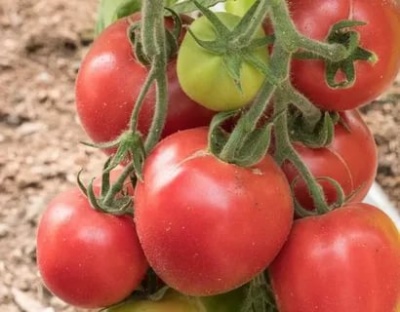
- Authors: IN AND. Blokin-Mechtalin
- Year of approval: 2019
- Category: hybrid
- Growth type: determinant
- Appointment: universal, fresh consumption
- Ripening period: early
- Ripening time, days: 95-100
- Growing conditions: for open ground, for film greenhouses, for closed ground
- Bush characteristic: compact
- Leaves: medium, green
The red Fuzzy tomato is a hybrid, as evidenced by the F1 prefix in its trade name. Plants are determinant, do not require additional height adjustment, thrive in greenhouses and in open ground. Fruits of universal purpose, are equally good both fresh and processed, do not give excess water, tolerate transportation well.
Breeding history
A hybrid of the first generation, obtained by the originator V.I.Blokin-Mechtalin from Moscow. It was officially entered into the State Register in 2019.
Description of the variety
Fuzzy red attracts attention with the compact size of the bushes. They are not spreading, covered with medium-dense green tops. Tomato inflorescences are simple, the first is laid above 7-8 leaves.
The height of the bushes in the open field does not exceed 80-90 cm. In greenhouses, they stretch out a little more. The stems are strong, strong, fleecy, the shoots are strong and resilient. Up to 7 fruits are formed in the brush.
The main qualities of the fruit
This hybrid got its unusual name thanks to its velvety skin; a light white fluff can be seen over the main red tone. Unripe tomatoes are green. The shape is simple, flat-round, the edges on the surface are weak. The average fruit weight reaches 140 g. There are 3-4 seed chambers inside the tomato.
Taste characteristics
The tomatoes in this hybrid have a juicy pulp of medium density. The taste is sweet and sour, with original aftertaste notes.
Ripening and fruiting
Early ripening tomatoes. Harvesting begins in 95-100 days.
Yield
Fruit collection rates of 11.8-12.5 kg / m2 allow the hybrid to be classified as fruitful.
The timing of planting seedlings and planting in the ground
The seed is placed in containers from mid-March. Seedlings can be transferred to a permanent place in 55-60 days from the moment of emergence.

Growing tomato seedlings is an extremely important process, because it largely depends on whether the gardener will be able to harvest at all. All aspects must be taken into account, from seedbed preparation to planting in the ground.
Landing scheme
It is recommended to place 3-4 plants per 1 m2.

Growing and care
Bushes of Fuzzy red lead in 1-2 stems. They need to be formed, without it, growth stops on the 4th stem, but the fruits are smaller, ripen longer. Garter stalks are required. Leaves under 1 fruit cluster are removed.
When growing tomatoes, it is necessary to provide them with watering - 5 liters per bush before flowering and 10 liters at the stage of gaining mass with fruits. During prolonged rainy periods, it is worth building a canopy outdoors to avoid excessive moisture.And also among the mandatory measures - feeding, weeding and loosening the soil in the root area.




A plant needs different micronutrients at each stage of growth. All fertilizers can be divided into two groups: mineral and organic. Folk remedies are often used: iodine, yeast, bird droppings, eggshells.
It is important to observe the rate and period of feeding. This also applies to folk remedies and organic fertilizers.
Disease and pest resistance
This hybrid is tolerant to late blight; additional prevention of this disease is required. Good resistance is genetically developed to Alternaria, TMV, Fusarium wilting. The hybrid is generally protected from viral and fungal diseases.
And also by experience it was possible to find out that Red Fuzzy is practically not affected by pests. It is well protected from attacks by whiteflies, ticks and aphids, which is very important when growing plants outdoors. Sucking insects are not interested in fluffy hybrids, since this protective coating prevents them from fixing to parts of the plant.


Resistant to adverse weather conditions
Fuzzy red grows well on heated, nutrient-rich soils. Does not like waterlogging, strong winds, return frosts. It is possible to transplant it to a permanent place in open ground only after the end of the cold weather.
Growing regions
Fuzzy red is suitable for growing in most regions - from the Moscow region and the Leningrad region to the Far East, the North Caucasus. The choice of planting method directly depends on the climatic and temperature norms.
Review overview
Summer residents have already appreciated this early hybrid. Fuzzy red is praised for its unpretentiousness, successful adaptation to the conditions of different climatic zones. Tomatoes are well suited for canning with whole fruits, tender pulp is perfectly processed into purees and juices, sauces. Summer residents note that tomatoes have time to ripen on the branches, they can lie up to 1 month after picking. Seed germination is also highly appreciated.
Relative disadvantages include the need for regular removal of stepchildren and rationing of the number of shoots.Due to the pubescence on the skin, the taste of the fruit is also considered quite controversial. On poor soils or in the absence of top dressing, the yield is noticeably reduced. Overflow in the root zone can lead to their decay.

























































































